 By Staff By Staff
July 2, 2015
BURLINGTON, ON
The Burlington Performing Arts Centre has created a new feature: the Lobby Showcase. Auditions are being held on September 19 and 20, from 10 am to 5 pm, for the Centre’s Lobby Showcase Project which will take place during the professional presenting season that starts in September/October 2015.
This is part of the Performing Arts Centre Community Engagement initiative that is intended to find new amateur talent in Burlington and surrounding areas to showcase local artists or acts that are in the process of developing their material and need some experience before a live audience.
 These performances will take place on a particular night to introduce these artists to our patrons and a wider audience. These performances will take place on a particular night to introduce these artists to our patrons and a wider audience.
The groups selected will perform in the theatre’s Family Room, that really grand space that a performer can do almost anything with. In the past there have been some superb events put on in that space.
The artists chosen for the Lobby Showcase will perform in the lobby before the main event starts.
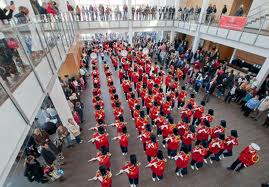 Room enough for the Burlington Teen Tour Band to perform – what do you have in the way of an entertainment event for this space? The intention is to assist local artists or groups on their way to becoming better known in the community. The hope is that some will eventually become professional.
There is no remuneration for the Lobby Showcases but artists will get an opportunity to market their brand at that time, while reaching a new audience. The artists may also be added to the City of Burlington’s Artists database, with their permission.
The selected performers will get one of eight available Lobby Showcase spots available throughout the 2015-2016 Presenting Season and they, as well as others selected, may also get a chance to be featured in the Culture Days celebrations, September 25 to 27, 2015.
 The Performing Arts Centre Community initiative is opening up some space for local amateur talent that will take place in the theatre lobby before a main production takes place. Their hope is that these events might be an early step towards an event that will get them to the Main Stage. We are looking for singer/songwriters, dancers, singers (pop, jazz, blues, folk, classical), bands or combos, instrumentalists and soloists (classical, jazz, etc.), performance art, and comedy; show us what you have.
Please submit your idea by email to: BPACAuditions@burlington.ca
Include a couple of photos, a short bio and some background information and a short description of the act or performer, include any links to YouTube videos, if you have them; don’t forget your contact information.
Dateline for submissions is July 24, 2015.
There are a limited number of spots available; only the acts or artists selected will be contacted with an audition date and time.

 By Staff By Staff
June 29, 2015
BURLINGTON, ON
For Monday, June 29, 2015 just the one sports field is closed:
Ireland D3
The Gazette publishes updates on sports facilities at city parks as soon as they are available.

 By Staff By Staff
June 28, 2015
BURLINGTON, ON
We talk about the jewels that make this city what it is – that Escarpment to the north of the city and that glistening lake that is there for us to watch and appreciate every day.
Those two magnificent geographic features were given to us- our task now is to enjoy that gift and serve as good stewards and ensure that what we have our grandchildren’s grandchildren will also be able to enjoy.
There are people who pay more attention to the environment that most of us – for them it is a passion and they spend countless hours just helping take care of what we have.
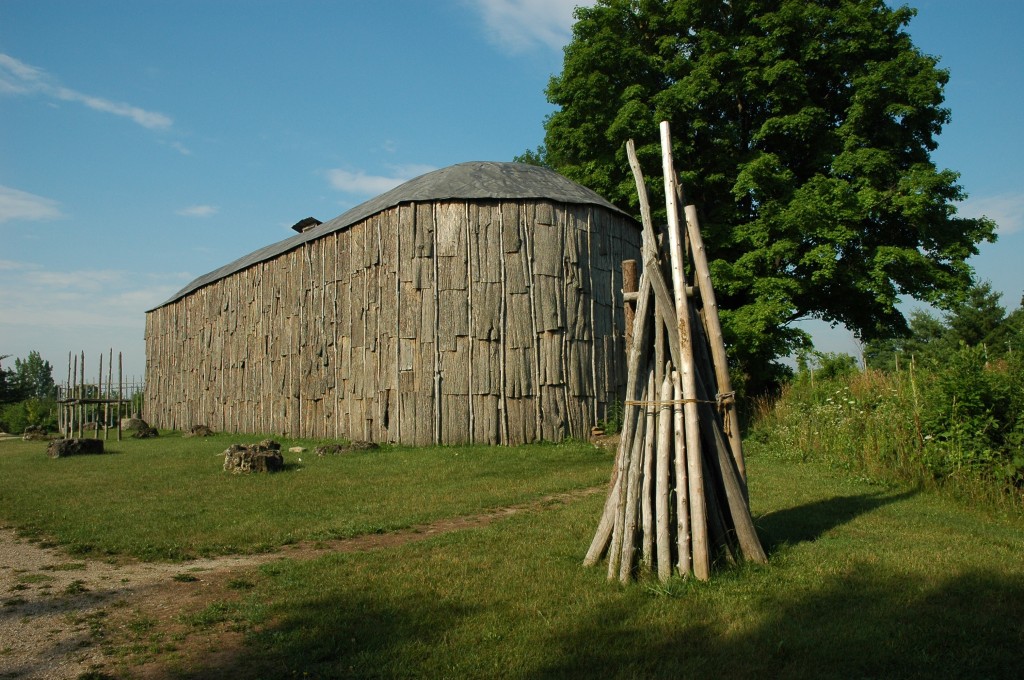 Turtle clan longhouse at Crawford Lake. The Conservation Authority, formed after Hurricane Hazel did some very serious flooding in 1954 when more than 90 people in Toronto lost their lives as a result of the flooding. .
There are a number of Conservation Authorities across the problem – Conservation Halton looks after what we have. They are both a regulatory agency that comments on all development that relates to the lake and the creeks and the land on the Escarpment and the operators of a number of recreational and entertainment locations including Crawford Lake.
They play a critical role that is seldom seen and rarely appreciated. Each year they hold an awards night to recognize those who have done more – made an effort and made a difference. They held their 33rd annual Conservation Halton Awards on Tuesday at the Milton Centre for the Arts. The awards are presented to people and organizations that make outstanding contributions to conservation in the Halton watershed, which includes Halton, Peel, Hamilton and Puslinch.
Every person, group, or school, in the various awards categories (except for the Parks Volunteer Award) are nominated from the community. The 2015 award recipients are as follows:
Citizen:Bethlehem Sahlu; Citizen (Youth) Simone Mantel, Aldershot District High School; Community Toronto Bruce Trail Club; Education (Group or School) Trailhead – Bronte Creek Project; Education (Individual) Nick Bertrand and Kerry Sagar, Halton District School Board; Media / Blogger, Tourism Burlington; Parks Volunteer Kirsten Phillip, Mountsberg Raptor Centre and Chuck Sweet, Kelso / Glen Eden; Stewardship Andrew and Marites Lee, Milton Field and Stream Rescue Team; Ralph Sherwood Honour Roll Keith Bird, Oakville
More than 150 guests and dignitaries attended the awards ceremony. In addition to the award recipients, Watershed Stewards in the Halton Watershed Stewardship Program were recognized, as well as local schools and childcare centres that participated in the Stream of Dreams education program.
2015 Conservation Halton Awards Recipients
Bethlehem Sahlu – Citizen
Bethlehem Sahlu has led three local food initiatives in Oakville. She is the coordinator of two community gardens, Share Land Share Life Community Garden (which is on privately owned land, Owner Mr. Armin Gottschling) and Clear View Community Garden. She also led a Green Your Mind Green Your Plate Presentation Series.
Share Land Share Life Community Garden and Clear View Community Garden were started as joint initiatives between Conservation Halton and FutureWatch EDEP as part of the Natural Connections Program aimed at connecting new and diverse communities in Halton to their natural surroundings, promoting food sustainability, healthy eating and Community engagement. (ODEC) Oakville’s Diverse Environmental Club Program is also a partner on Clear View.
Green Your Mind Green Your Plate is an interactive presentation with the objective to give people who are new in the area an overview of the local food market, to emphasize the importance of eating healthy and locally, and introduce them to the basic concepts of food sustainability. Bethlehem enjoys sharing her passion and knowledge about food sustainability and she believes Environmental Education is the key to success in all the community initiative she has been involved in. Bethlehem has inspired people that change is possible and it starts from the community we live in!
 Simone Mantel – an Aldershot residnent Simone Mantel of Aldershot High School in Burlington – Citizen (Youth)
Simone has been a true Environmental Champion for Aldershot School and the City of Burlington. She has been actively involved in her four years as a high school student, serving as President of the Aldershot School Environment Club and is a Graduate of the ECO Studies Program. Simone organized a community environmental film screening to raise funds for a school habitat restoration project. She also participated and planned invasive species removals at Aldershot School and Royal Botanical Gardens, and also organized school clean-up events for Earth Day.
Simone is involved in the community as well. She is an active member of Burlington Green, and worked to save trumpeter swan habitat at LaSalle Park Marina. She is a Burlington Transit Youth Ambassador for Aldershot School and organized several transportation-related campaigns. She also facilitated the ECO Rangers Environmental Leadership Program at RBG (grade 6 and 7 students).
Due to Simone’s dedication and commitment to the environment, Aldershot school and community, as well as the City of Burlington, have seen significant improvements in the awareness of environmental issues and improvement and protection of natural areas.
Toronto Bruce Trail Club – Community
Members of the Toronto Bruce Trail Club undertook the cleanup of downed trees and branches following the ice storm in December 2013 to reopen the Bruce Trail for hikers. Their clean-up efforts on the Main Bruce Trail in Halton Region involved more than 150 volunteers, who contributed over 600 hours and the cleanup was so extensive it took two years to fully complete.
The Toronto Bruce Trail Club encompasses the northern section of the Bruce Trail in Conservation Halton’s Watershed, this includes Crawford Lake, Hilton Falls, Kelso and Rattlesnake Point Conservation Areas.
Toronto Bruce Trail Club work parties cleared approximately 70% of the Main Trail from January to June 2014. The Bruce Trail and Conservation Halton has been extremely fortunate to have so many dedicated and interested volunteers show up so many times to get cold and dirty, and work very hard to clean up and maintain the trail for others to enjoy.
Trailhead – Bronte Creek Project – Education (Group or School)
Trailhead is a one semester environmental leadership program for 20 grade 10 students. The Trailhead class is made up of students selected from all Halton public and Catholic schools who have applied to be part of this unique and often transformative program.
Students spend every day at Sidrabene, which is located in a rural area, for the five-month high school semester. These facilities allow BCP students to have a mix of outdoor activities and indoor classroom lessons. Trailhead students teach grade 4 elementary students a one-day program called Novice Earthkeepers, where they practice and teach environmental stewardship. For the past three years, Trailhead students have participated at the Halton Forest Festival for Conservation Halton teaching grade 6 and 7 students about the importance of our local forests and the plants and animals that live within them.
Trailhead students explore current environmental issues and human impact, and discover their own relationship with nature. Hands-on learning is at the core of the program, allowing students to experience the curriculum while also learning about different career paths. The semester also involves an Adventure Trip canoeing in Algonquin Park. The program truly is a one of a kind experience for students, led by passionate and knowledgeable staff.
 Nick Bertrand and Kelly Sager of the Halton District School Board couldn’t keep away from their cell phones as they tweeted their award to everyone they knew Nick Bertrand and Kerry Sagar from HDSB – Education (Individual)
Kerry Sagar is an Instructional Program Leader with the School Programs Department at Halton District School Board. She has been involved in Environmental and Sustainability initiatives throughout her career with a special emphasis on Social Justice, Equity and Inclusion, and First Nations, Métis, and Inuit perspectives.
Kerry has been instrumental in developing invaluable resources, as well as developing and presenting countless professional learning experiences to elementary and secondary HDSB teachers, administrators, and superintendents. Her longstanding work with environmental leadership teams at the board level has included the development of inquiry-based learning projects which are directly connected to care and protection of the environment, and include a deeper understanding of the underlying social and equity issues.
Nick Bertrand is also an Instructional Program Leader with the School Programs Department at the Halton District School Board. After a teaching career at White Oaks Secondary School, He joined the School Programs Department three years ago.
Nick has had phenomenal success in working directly to support the Ontario EcoSchools program with secondary schools. Nick Co-chairs the system level Eco Team, HELP (Halton Eco Leadership Partners), and the multiple community partner Outdoor Experiential Education Advisory Team. One of his major accomplishments has been the successful implementation of First Nations, Métis, and Inuit Education at both the elementary and secondary level; his connections with local First Nations and other community partners has enabled him to provide powerful support to schools in integrating First Nations, Métis, and Inuit Education, Environmental Education, and Outdoor Experiential Education.
 Linda Cvetanovic, blogger extraordinaire with Tourism Burlington was recognized Tourism Burlington – Media / Blogger
Tourism Burlington consistently supports Conservation Halton’s recreational, educational, and environmental initiatives on their online account. They furiously share tweets about events at Halton Parks, like Maple Town or Endangered Species Weekend. By doing so, Tourism Burlington captivates the online community in regard to outdoor education and our environmental efforts. Not only does Tourism Burlington engage with Conservation Halton, but they also collaborate with other groups to promote and educate others about nature in Burlington. With over 8,000 followers on Twitter, Tourism Burlington is an industry leader in Tourism for online media.
Tourism Burlington tweets and retweets Conservation Halton’s content whether it is a blog about a baby barn owl, or a Facebook link about Endangered Species Weekend at Mountsberg.
Kirsten Phillip, Mountsberg Raptor Centre – Parks Volunteer
Kirsten volunteers at the Mountsberg Raptor Centre every Friday. She is always pleasant and excited to be at Mountsberg and is a joy for the staff to work with. She happily does whatever task is asked of her and has become a master at cleaning the flight cages. Staff don’t quite know how she does it, but Kirsten gets the Turkey Vulture flight cleaner than anyone – even the staff.
When asked to do a spring cleaning on a Wildlife Walkway pen, she remarked at the end of the day that it was her most fun day yet of volunteering! Kirsten has gone above and beyond the duties of a regular volunteer.
On her own time and with her own resources, she developed two matching card games to be used by visitors at the park and these games will be incorporated into the summer Raptor Camp activities this year. She has also started to join Mountsberg staff on offsite presentations and is a great representative of Conservation Halton both offsite and at the park. All of the Raptor Centre staff looks forward to Fridays, when they get to share their day with Kirsten.
Chuck Sweet – Parks Volunteer
During the winter months Chuck is a volunteer patroller at Glen Eden and during the summer months Chuck is a volunteer trail ambassador at Kelso.
Chuck performs at least 140 hours of volunteering per winter helping injured skiers and snowboarders. He is an inspiration to many of our volunteer patrollers through his attendance, commitment, and dedication.
Chuck is an exceptional communicator as a trail ambassador in regards to safety and offering direction. Chuck was seriously injured while on duty as a ski patroller during the 2013-14 season. He returned this season and fulfilled his responsibilities well beyond our expectations. His peers nominated Chuck as Patroller of the year at the end of the 2014-15 season.
Andrew and Marites Lee – Stewardship
Andrew and Marites were two stand-out participants of Conservation Halton’s 2014 Healthy Neighbourshed homeowner workshop program. At each week’s session, they were eager to learn and were inspired and motivated to implement a low impact landscaping project on their property.
Not only did they add to the community of the workshop series by asking questions and discussing topics with fellow participants, they took the projects they learned about home. Andrew and Marites completely revamped their backyard to incorporate low impact development principles. These include: a permeable walkway, native plants and a rain barrel.
Their efforts and enthusiasm are not only helping divert our watershed’s urban run-off, they are acting as environmental stewards to their children and their community by showing what can be done on a homeowner’s property can be both beautiful and environmentally friendly. Andrew and Marites have also demonstrated that even if you live in a suburban subdivision, you still can have a positive impact on your local environment.
 David Hulsman of the Field and Stream Rescue  Jeff Stock – Field and Stream Rescuer Field and Stream Rescue Team – Stewardship
The Field and Stream Rescue Team is a not for profit group that works in Hamilton and Halton. They are 100 per cent volunteer based with a board of eight members and a project planning team of about the same. Their mission is to “Revitalize urban areas by restoring and rehabilitating watercourses, forests and natural areas through community education and hands on activities.”
They accomplish their mission by leading 15 to 20 volunteer workdays per year. Workdays include a variety of projects types such as invasive plant management, garbage cleanups and tree, shrub and wildflower plantings.
A niche that they have filled in Conservation Halton’s area is to clean up the nearly impossible. They rig up a system of pullies and cart garbage out of deep forested ravines that has likely been there for fifty plus years. One of their greatest achievements of late was a two day cleanup of an old dumping site in Bronte Creek Provincial Park. Tires, fridge, freezer and more were hauled out of the Bronte Creek floodplain and up a 150 foot ravine.
Keith Bird – Ralph Sherwood Honour Roll Award
Keith Bird recently served as Vice Chair of Conservation Halton and was a member of the Conservation Halton Foundation Board from 2011 to 2015. Keith served 37 years on the Conservation Halton Board, serving since 1974, except for two years when he was on the Conservation Halton Foundation Board.
During Keith’s time, the Foundation completed the Mountsberg Shrike Project breeding facility, the Deer Clan longhouse which was constructed at Crawford Lake Conservation Area, and the Foundation provided ongoing support for the Halton Children’s Water Festival and the Halton Forest Festival.
During Keith’s yeas on the Conservation Halton board there were a number of improvements at the conservation areas highlighted by the opening of the Crawford Lake Iroquoian Village and the building of the Kelly New Pavilion at Mountsberg. In addition there have been upgrades at Glen Eden to the chairlifts and snowmaking and a new pedestrian bridge built over the railway tracks to accommodate the growing demand. Another park improvement during Keith’s time was the opening of the Brock Harris Lookout at Mount Nemo.
 Proudly displayed on the gate of rural homes – some in urban areas as well. Halton Watershed Stewardship (HWSP) Program Award Recipients
The Halton Watershed Stewardship Program award recipients are members of a group of more than 310 landowners voluntarily protecting over 12,800 acres of land, which includes over 7,800 acres of natural land, and over 160 kilometres of stream. It is important to remember that by simply enjoying these natural heritage features as they are, and conserving them for future generations, Watershed Stewards are making a significant contribution to the health of the environment, which leads to a healthy society.
Each year Watershed Stewardship Technicians assist landowners who are looking for advice and recommendations regarding activities they can undertake to restore woodlands, wetlands, meadows, and streams. The following landowners were recognized at this year’s award as Watershed Stewards:
• Alba DiCenso and Brian Hutchison in the Bronte Creek Watershed
• The City of Hamilton for Courtcliffe Park in the Bronte Creek Watershed
• Wayne Terryberry, who is the first recipient of the new Cootes to Escarpment EcoPark System dedicated Stewardship award
 These Streams of Dreams are hand painted by students and affixed to school yard fences – a graphic and fun way to teach young students about the environment. Stream of Dreams 2015
The mission of the Stream of Dreams Program is to educate communities about their watersheds, rivers and streams, while dazzling them with the charm of community art. Since its launch in 2006, Conservation Halton staff has delivered the program to 32,422 participants at 83 schools, as well as many community events, installing these magnificent murals across the watershed.
The teachers and parent volunteers at the participating Stream of Dreams schools put countless hours of work into each project to prepare their fish to be painted by the children and then install their murals on a fence at the school. Conservation Halton staff deliver the program with the message of protecting the fish and other wildlife who live in our community streams. The following schools participated over the past year:
• Balaclava, Freelton
• Bruce T. Lindley, Burlington
• Glenburnie, Oakville
• Hawthorne Village, Milton
• Our Lady of Fatima, Milton
• Palermo, Oakville
• Pilgrim Wood, Oakville
• Pine Grove, Oakville
• P.L. Robertson, Milton
• St. Mildred’s Lightbourn, Oakville

 By Walter Byj By Walter Byj
June 29th, 2015
BURLINGTON, ON
School is out for the summer; both the students and the trustees will return in September.
The trustees can enjoy the summer and tend to the projects they will have to deal with – including the selection of a new Director of Education, David Euale retires at the end of August.
Upon their return, the trustees will have a new face at their initial meeting in September: Jacqueline Newton, currently the principal at Dr. Frank J Hayden Secondary School, has been appointed as the new Superintendent of Education filling the void of departing superintendent Yaw Obeng who will head a school district in Burlington Vermont. Newton will move into her office at the Board August 24th.
Smart appointment
The June 24th meeting was relatively quick as the following action items were ratified;
Program Viability Report
Truth and Reconciliation Report
Capital Priorities Report
Draft Policy-Trustee Expenses
Policy Schedule Amendment
There was brief discussion on the Program Viability Report with Associate Director of Education Miller reaffirming that this motion was still in the infant stages and that nothing would happen until thorough public consultation was completed.
The Board passed the following resolution which sets out the options as they are seen at this point in time. There is to be considerable public consultation on this matter before any decisions are made.
Be it resolved that the Halton District School Board present the following options for the delivery of French Immersion to the public in the Fall of 2015 for the purpose of receiving feedback, considerations and comments. Feedback will be brought to the Board for consideration in the delivery of French Immersion programming:
1. Option 1: Grade 1 (early) French immersion remains a 50% French 50% English delivery model, but entry to FI will be capped. The method of capping would be determined at a later date.
2. Option 2: Grade 1 (early) French Immersion remains at 50% French and 50% English, however all FI programs will be delivered in single track FI schools. French Immersion will be phased out of dual track schools and no new dual track schools will be considered. The location of the single track schools will be determined at a later date.
3. Option 3: French Immersion will commence at a later entry point (mid entry); Grade 4. This will result in the delivery model of FI moving from a 50% model to at least a 80% French Immersion model. In addition the delivery of FI will occur in dual track schools only.
4. Option 4: French Immersion will commence at a later entry point (mid entry); Grade 4. This will result in the delivery model of FI moving from a 50% model to at least a 80% French Immersion model. In addition the delivery of FI will occur in single track FI schools only.
 Amy Collard  Leah Reynolds  Andrea Grebenc  Richelle Papin Three of Burlington’s four school board trustees have completed the school season part of their first year in office. How have they done so far – what kind of a contribution have they made?
Spotty is the best way to describe what we have seen so far.
Harvey Hope (Oakville) insisted that the word “will” in the original motion be changed to “would”. She felt that “will” was too strong a word and should be changed to “would”. Flipping through my thesaurus, I found that would is the past tense of will but her fellow trustees approved the change. Perhaps our scholarly readers could impart some point of view on the correct word. Either way, this report will continue to be followed in depth in September. Details on the other motions will follow.
This was followed by G. Cullen (Superintendent of Facility Services) presented a report that reflected the current facility deficiencies at the administrative offices of the Halton board and the need for new facilities in the not too distant future. They are in the initial stages and further details will follow. The office would move to the best location possible; it could move out of Burlington. Any change is five years out.

 By Staff By Staff
June 27, 2015
BURLINGTON, ON
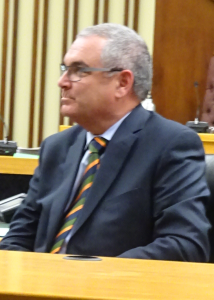 City manager James Ridge wants union workers to understand the issues before the walk off their jobs. In a message to the citizens of the city Burlington city manager James Ridge, who seldom makes public comments, said on the city’s web site:
The City of Burlington’s bargaining committee is scheduled to meet with the union’s bargaining committee on Monday, June 29, 2015. The city is committed to working hard to reach a resolution that is fair to our employees and responsible to our taxpayers. If we are unsuccessful, the union has advised us that we can expect a strike.
To be very clear, the city does not want a strike. Strikes are hard on everyone–union members, management, City Council and, most especially, city residents.
Before you go on strike, we urge you to understand the issues and make sure you communicate your views with your union. We simply ask that you know what is at stake and make good decisions.
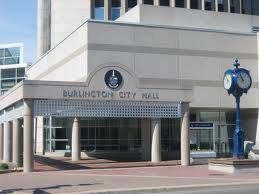 Will there be picket lines around city hall? That last sentenced had the thread of threat in it – well what are the issues and what is at stake?
Corporations are usually loath to involve media in the labour bargaining process – it muddies things up. The city is negotiating collective agreements with two unions: CUPE Local 44, outside workers and arena/outdoor pool operators, and Local 2723, Burlington Transit workers. Both unions have stated that if there is no agreement by the end of June, they will begin strike action as of midnight (12:01 a.m.) on July 2, 2015.
The unions maintain that benefits for workers over the age of 65 are written into the existing collective agreement but are not being paid. A staff member at a senior level who asked not to be named has said that the city and the outside workers are “not that far apart but that there is considerable distance between the city and the transit drivers.”
Burlington’s transit drivers earn considerably less than their counterparts in Hamilton and Oakville.
If there is a strike there will certainly be picket lines – will the inside workers cross those pickets lines.
Get ready for some disruption.

 By Pepper Parr By Pepper Parr
June 29th, 2015
BURLINGTON, ON
Vince Fiorito teaches and instructs people in the arcane science of information technology. He knows all about Virtual Private Networks; how to set them up and how to keep them both running and safe from the cyber bandits.
He has been around information technology since its inception and while he hasn’t invented anything or become ridiculously rich he is content with what he is able to earn.
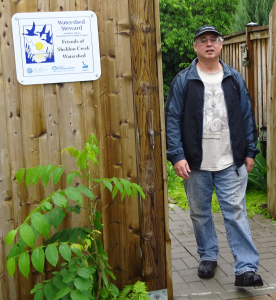 The Halton Hamilton Watershed Protection group and Conservation Authority issues these placards – they are prized possessions in the rural part of the region. The passion for Fiorito is the environment – and here he has become an absolute bulldog. Fiorito will see a lush green lawn and know that it was treated with some chemical that is polluting the creeks and streams that run through Burlington and into the lake – our water supply. That makes the hair on the back of his neck bristle.
When Fiorito and his wife went looking for a home in Burlington he knew that he wanted a ravine property; it was his wife who found what they were looking for. His back yard is a slope that is landscaped with stones – not as much as a blade of grass to cut but a clear view directly into the flow of Sheldon Creek that runs from the watershed in the Escarpment through the city and into Lake Ontario.
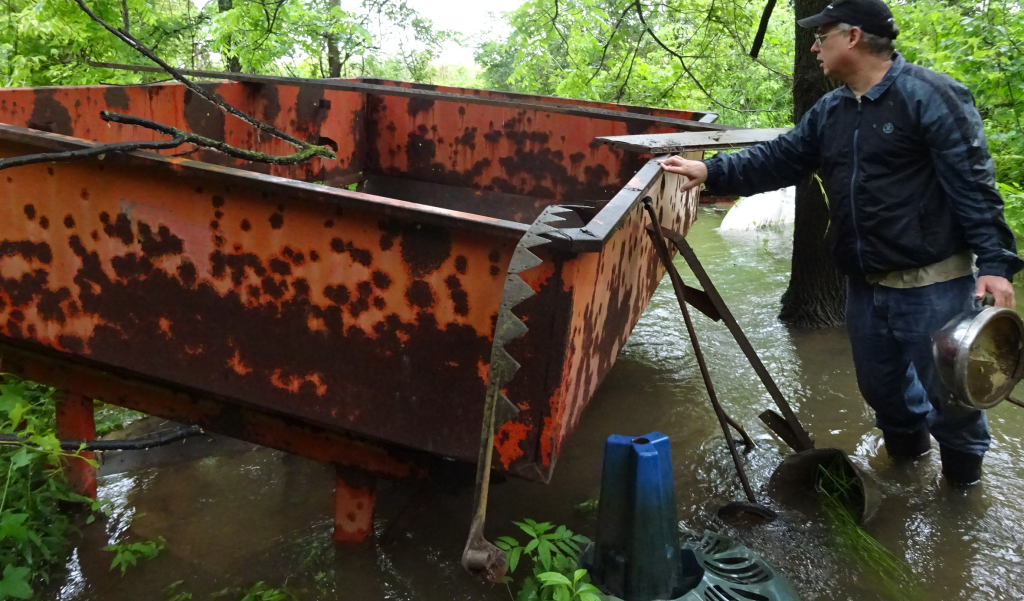 This hunk of metal has obviously been in the creek since before the development surrounding the creek was constructed. A farmer or the developer that bought the farmland just left it; does the city not inspect the land at all during the construction phase. Getting it out is going to be a challenge. Sheldon Creek is Vince Fiorito country – he has a sign into his back yard that declares he is the Friend of Sheldon Creek. His reputation has spread throughout the city. During one of his Inspire speeches Mayor Goldring was taking questions from the audience – Vince was on his feet and asking the Mayor what his position was on the cleaning of the creeks. Goldring recognized the name and said “you’re the guy that cleans the Sheldon Creek” – not bad in terms of recognition.
Fiorito has walked every foot of the creek from Upper Middle Road to the Lake – during the summer he expects to trace the path of the creek from Upper Middle Road to its headwaters in the Escarpment
During a delegation before a city Standing Committee Fiorito upbraided council for not keeping the creeks cleaner – pointing out that they were city property.
Councillor Craven took exception to that comment and said it wasn’t city property but the property of people whose property who bordered on the flood plain. Staff corrected the Council member – it was for the most part city property they said; the decent thing to do would have been for Craven to apologize to Fiorito and listen to what the man had to say but that isn’t the currency Craven deals in.
Fiorito can recite chapter and verse on how many tonnes of garbage have been removed from Sheldon Creek and had the photographic evidence to back up his point.
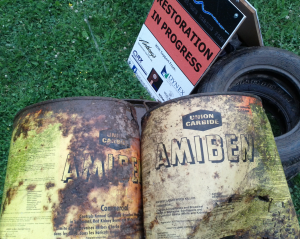 Not toxic but not the kind of thing you want adventurous boys coming across when they play in the creeks. When Fiorito came across the two 40 gallon barrels and the cans of chemicals in Sheldon Creek his first instinct was to inform the Ontario Ministry of the Environment. Easier said than done. There was no phone number; there was a form he could complete and did.
Fiorito didn’t understand why he couldn’t send a GPS marker to the Ministry so they would know exactly where to look.
 The back up here is due to a fallen tree – there is no one culling the forestry – the result is small damn that get created and catch everything flowing through the creek. There is more work to be done on the Sheldon Creek and while Fiorito gets quite cranked up about the environmental mess and isn’t the least bit shy about warning neighbours about the potential harm – the truth is Sheldon Creek is a mess and it is city property and while it will cost a pretty penny to clean it up from top to bottom there is the potential for flooding and the backing up of the spring runs offs – and there might be some junk in there that could be dangerous.
Burlington has 10 creeks that flow through the city and into the lake. They are for the most part abandoned with no one paying much in the way of attention to them. The city got a very rude awakening when the August 4th flood hit the city last summer. The practice before the flood was not to do all that much to the creeks; the natural approach, just leave everything that falls into the creek bed wherever it falls, was both cheaper and though to be environmentally sound.
That 191 mm of rain in a single day resulted in water roaring down those creeks and that harmless tree stump became a battering ram that lifted large pieces of concrete on New Street.
 It was a backed up creek that brought the flood water over this bridge Creeks got plugged and water began flowing into the streets and basements were flooded – the wonder is that some lawyer in town didn’t see the potential for a class action law suit and go after the city for tens of thousands in claims arguing that the city was negligent – which it has been.
Last week Conservation Halton held its annual awards night in Milton where it recognized those who had made significant contributions to the preservation of the environment
After the flooding brought on by Hurricane Hazel in 1954 that resulted in more than 90 deaths, flood control in Ontario and Canada as a whole became a more important issue.
Fiorito has nothing but positive words for the work BurlingtonGreen does each year when it spends the best part of a Saturday organizing thousands of people to help clean up the trash in the city – but makes this observation:
We have thousands of people helping clean up but we appear to have thousands who are littering our creeks – hundreds of vehicle tires have been pulled out the creek and they didn’t just fall of a passing car.
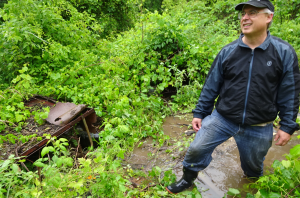 Vince Firoito thinks there might be some scrap metal revenue in the creeks – is is salvageable? Part of his mission is to clean the creeks and keep them clean. Fiorito has a mission: he is the Friend of Sheldon Creek – now wants every creek in the city to have a friend and people who will serve as stewards of the creeks to oversee their environmental health.
In the fullness of time Fiorito hopes that the stewards of the city’s creeks will begin to have some influence on the city’s elected council and encourage them to put some resources into rehabilitating the creeks.
In some city’s the ravines are quiet laces for people to walk and just enjoy being outside. Burlington has been spoiled – most people are just vaguely aware that there are all those creeks running through the city. Vince Fiorito is setting out to change that perception.

 By James Smith By James Smith
June 28, 2015
BURLINGTON, ON
Can a tool change the world?
What about a tool to change Burlington?
Marshal McLuhan said, “We shape the tool, then the tool shapes us”. Don’t agree? If you’re reading this, an online newspaper, the very action of reading stuff online has, in fact, transformed you.
This is a piece about how choices of designers’ tools have shaped not only the practice of design, but more importantly how the results may shape our city.
Burlington’s had its share of great plans but executing these plans may be why Burlington is a place where NIMBY is king and why Burlington as a city has never lived up to its potential. Perhaps with a better set of tools, designers can help citizens and politicians awaken Burlington to its potential.
As a designer, I’ve a fascination how the tools of the trade have changed the approach to our work and how these changes have modified our designs. Technological change is often at the heart of transformation; think of it this way: before movies, no movie stars, before Video Games, no 3D animators. Similarly, in architectural design, before Computer Aided Design and Drafting (CADD or CAD) the architect’s world was a very different place than it is today. A place where changes to a project, even in conceptual design were difficult to implement due in part because a huge commitment of resources was required to produce a building project’s design as everything was drawn by hand.
 How much “cut and paste” was there to this design? Citizens who saw early drawings complained that there wasn’t much creativity to the project. Not very livable was another comment. Why should we care? The development industry may be the impetus behind any building project, but the work of the urban planners, architects and other designers’ shape these projects. The city and its residents live with the results of their work. When tools allow a design firm to simply Copy and Paste a developer’s requests, a resulting project perhaps technically sound, is likely more of a commodity than handsome design. The city is poorer for this kind of design.
Intensification, for example, gets a bad reputation if produced as the result of a Copy and Paste process rather than employing more innovative design. As a city we need to demand better from our development community and the designers engaged. But good design takes time; and time is money so to better manage the process effectively, perhaps design firms need better tools.
Twenty-five years ago, most architects, engineers, interior designers, landscape architects, and urban planners’ tool sets had not changed a great deal in a hundred years. Paper, pencils, ink and blueprints were still the stock-in-trade for most professionals. In part because the design of anything is very labour intensive with much proprietary information; plans tend to be closely guarded secrets between client and design firm. Even when these plans are for projects to be executed on behalf of the public. The process now is generally better, but improvements to the process need to be made.
 Before electronic digital design tools were available everything was drawn by hand – and changes were minimal which meant less creativity. Change may be coming if some of the architects and urban planners I spoke to recently have anything to say about the issue. I joined about 300 designers from many disciplines from around the world to talk shop about the tool they use to change their part of the world at the Vectorworks Design Summit in Philadelphia. (https://www.vectorworks.net/design-summit) Noted Landscape Architect and urban planner Adrian McGregor (https://is.gd/S6Dq0h ) of Sidney Australia claimed “Cities are the greatest cultural achievement of human kind”.
A pretty bold statement, especially when we look at the kind of car-centric city and region we live in. McGregor went on to qualify his statement by saying in executing city design and construction “… we’ve forgotten what was important to the foundations of cities”. Could this be due, in part to the technology used by designers? I would argue yes.
Vectorworks CAD software users are an interesting, and eclectic group of professional designers from a number of disciplines. Half a million very loyal users and 30 years later founder and Chairman Mr. Richard Diehl told me at lunch the other day, part of his inspiration in developing CAD software came in a university class. A professor wrote a formula on the blackboard and said to the class “you can make money and found a company with this algorithm”. Rich quickly wrote down that algorithm! Thirty years ago CAD on a Mac was a breakthrough; at the time CAD systems took up entire rooms and were only available to NASA, Boeing, GM or SNC/Lavalin. Products like Vectorworks (then called MiniCAD) and AutoCad have transformed the design industry as firms could produce and store documents required for building anything, in a mechanized way, even in very small practices. This had profound implications for design companies, as armies of people at drafting boards were no longer required to complete a project.
The Vectorworks CEO Sean Flaherty demands his company focus on a desire “to change the design process”. Vectorworks according to Flaherty has “never fit neatly into a slot” and he told me candidly the “why of the company” is rooted in asking, “what are the needs of designers” who use this tool. Somewhat refreshing to hear a CEO not hammer on some marketers’ tag line or so called mission statement. Mr. Flaherty seems genuinely committed not just to his company, but to the needs of the design community and wants Vectorworks to assist the Design community in addressing many challenges we face as a society.
 The software available to day can be used to create images of project sites that give the public a view of what is planned and ideally give them an opportunity to comment. Mr. Flaherty’s passion seemed evident when he said “.. we are currently teaching our kids that architecture is now a luxury good” and that this is “a trend I fear for the whole built world”. In an effort to move away from this trend of making design just for the 1% Flaherty, who thinks, “design really matters” wants to ensure “Vectorworks goal is usability and simplicity”.
Usability and simplicity are goals everyone wants but achieving it’s a difficult process. Sean Flaherty told me his company’s approach is “not to focus on technology but on the users goals” and that “moving data around is not the problem”. ” Telling the customer: You’re doing it wrong! ” is something his engineers need to avoid, and rather the user needs to be “an active participant” where the process of evolving software “needs to be a conversation, not to limit a designer’s choices, but rather you (the user) should be able to choose your own tool and mix and match to get desired result”.
 Realistic renderings of proposed building developments lets a public see what a building is going to look like. In the old days of pencil and paper world, designers used many tools to achieve their desired effect, and the tension to be told to do something one way tends to irk a creative mind. Many CAD software products limit user’s choices on how to produce construction documents. Sean Flaherty suggests with Vectorworks a “multi discipline approach” to architectural design “could change the way architecture is practiced”.
While there are dozens of pieces of CAD software in the world and designers have been using them for years now. If Vectorworks, as a tool, has at its core an interface and a structure more collaborative this may open the door to a more collaborative city building process. Time will tell.
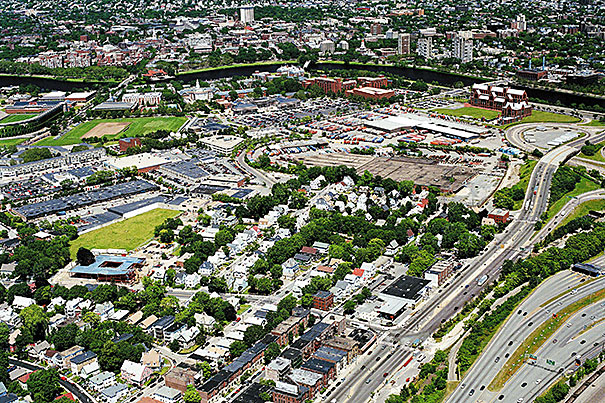 The software available today allows designers to provide a very large scale view of the expected result. It also allows all the contractors involved in the construction to interact with the various levels of the software. What is about to have the most transformative change to CAD, and in turn to city building is something called Building Information Modeling, or BIM. Much of this conference was devoted to the future of BIM, how it works, and how to collaborate with other disciplines using Vectorworks.
So what is BIM? Dr. Biplab Sakar, chief technology officer of Nemetschek Vectorworks told me “BIM is not a piece of software or a thing, but a process”. This process allows all experts who contribute drawings and specification to a building project to share these components back and forth. Most significantly BIM also allows for each component to be shared as a 3D object.
 Building Information Management allows designers to drill down to a specific part a part of a large building – the pipes that will carry water and electrical conduit and steam for heating for example to be looked at closely when they want that level of detail. Think of BIM as the rules of a giant LEGO set on a computer where each consultant sends the Architect his or her pieces of LEGO. BIM would be the rules allowing all pieces conform to so regardless of shape size colour or use the parts will work with other pieces of LEGO. BIM allows pipes, beams, shafts, walls doors or windows from, whatever software, to be shared.
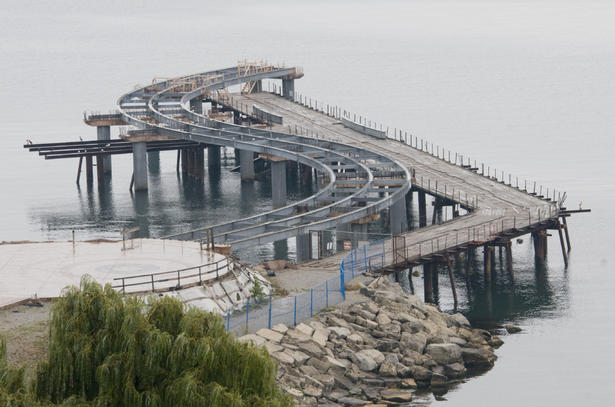 Had Building Information Management software been used on the construction of the pier would we have had a different, less expensive pier? In a BIM model a building is constructed as a 3D model on a computer so potential conflicts are resolved in planning stages rather than on a construction site. One has to wonder if Vectorworks and BIM might have ensured the Burlington Pier might have been built in less time, with fewer mistakes and in a more cost effective manner.
BIM has potential not just for building science, but also for large development projects to improve community engagement at the start of a project, and further improve communication of the designer’s intention of a project with the community.
The tools we use can and usually does determine a large part of the quality of the project that is being built.

 By Staff By Staff
June 26, 2015
BURLINGTON,ON
For the second year the citizens of Burlington will have an opportunity to sign a Book of Best wishes to Prince George Alexander Louis of Cambridge who will turn two on July 22nd this year.
 The cover of the 2014 Book of Best Wishes sent to Prince George to commemorate his first birthday.. Citizens will be able to sign the second birthday Book of |Best Wishes outside the Brant Museum on Canada Day The Burlington Gazette has sponsored this initiative. Last year beautifully leather bound book was shipped to the Governor General at Rideau Hall who sent it along to Kensington Palace.
The Book of Best wishes will be set out at several locations around the city – and will be on display outside the Brant Museum where people can sign the book and take away a commemorative book mark.
 A commemorative book mark will be given to all those who sign the Book of Best Wishes. Our eager promotional team will be on the grounds wearing their Burlington Gazette T-shirts and directing people to the museum where the Book of Best Wishes will be available for signing from 10 am to 4 pm on Canada.
The Book of Best Wishes was bound in a deep burgundy leather with green trip.
The 2015 edition will be bound in red leather with blue trim.

 By Pepper By Pepper
June 26, 2015
BURLINGTON, ON
Some people in each community listen carefully, ask probing questions and trust their member of Council to keep them up to date on what is happening in their community and to protect the best the community has.
Every member of a city council has their own unique style; something that defines who they are and the way they see their job.
In Burlington there are a number of different political styles. Councillor Marianne Meed Ward was once out on Christmas Day picking up garbage when a resident called her t complain.
During the flood last August Ward 4 Councillor Jack Dennison walked into hundreds of basements to personally see the damage done.
Ward 5 Councillor Paul Sharman put his heart on his sleeve when her spoke to a group of Rotarians during the Rubfest launch and pleaded for help for the people in his community.
Ward 3 Councillor John Taylor doesn’t hold meetings for his constituents – they are more like family get togethers – he has been in office that long.
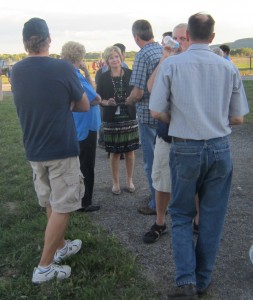 Blair Lancaster – almost holding court with her constituents at a corn roast. Blair Lancaster in ward 6 tends to have two different public styles; one that gets used for those south of Dundas and another that gets used when she is politicking north of Dundas; there is nothing duplicitous ion this approach – she is dealing with two different mind sets and adjust her message to meet her understanding of each community.
Ward 1 Councillor Rick Craven, who gave up talking to the Gazette when we wrote something about him he didn’t like, held a community meeting.
Last Wednesday evening Councillor Craven held a community meeting to talk about the 324 townhouse project on Masonry Court being developed by the ADI Group. It wasn’t a particularly unpopular project – the meeting didn’t cheer when the presentation was over – they just thought the developer could do something that was more “livable” and “imaginative”. “Not very creative” was the most stinging comment. He was speaking to an audience of about 40 people who were for the most part involved in their community and wanted to know more.
Councillor told them that the population of Aldershot had grown by just 4000 people in the last 15 years and that without more in the way of growth the chances of there ever seeing a grocery store in the west end of the community were very slim.
 Rick Craven: Best committee chair the city has; not big on the warm fuzzy stuff through. Needs a hug badly.  Ward 1 Councillor Rick Craven – seems to have forgotten everything he knew about the ADI project on Martha at Lakeshore Road. The meeting was just like most community meetings in Aldershot; people listened and asked questions and for the most part got fair answers.
Until ..
Until one woman asked the speaker from the ADI Group to tell her a little about the company – she’d never heard of them before.
The company representative told their story – sort of. He skirted totally the situation with the 28 storey application that ADI had made to the city for an application at the corner of Martha and Lakeshore Road which the city and planning department was completely against – including Councillor Craven.
 The ADI Group’s 28 storey development proposal on the downtown core was not mentioned at a meeting about their Masonry Court development. The rules that govern development applications are such that if the planning department doesn’t do something with an application the developer can take their case to the Ontario Municipal Board. Burlington city council didn’t get to vote formally on the project within that 180 day window.
On the 181st day ADI had taken their case to the OMB.
The project is one that the city feels is a mistake from a development point of view and has been consistently vocal about.
But not a word about this issue from Councillor Craven when a constituent asked to know more about the company.
Councillor Craven had an obligation to tell his constituents that there was a problem with a major ADI development application and they were playing a very sharp game – albeit within the rules of the game.
Craven’s behavior gives a whole new definition to politicians being in bed with developers.
Background links:
Aldershot community meeting Wednesday June 23rd, 2015
Full profile on ward 1 Councillor.
Councillor chooses not to represent his constituents; property expropriated.

 By Staff By Staff
June 24, 2015
BURLINGTON, ON
WHAT: The Naked Craft Network is an international research project that brings together the best of contemporary Canadian and Scottish craft. and the general public to discuss the themes explored throughout the Naked Craft Project, and to look forward to the future of craft.
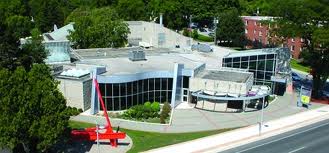 Saturday – 10 to 4 – Naked Artists take over the AGB. WHEN and WHERE: Saturday, June 27, 2015 from 10am – 5pm at the Art Gallery of Burlington
The word Naked certainly caught my attention. Tell me more.
Speakers
 Denis Longchamps – curator at the AGB will be speaking at the symposium • Dr. Sandra Alfoldy, Professor of Craft History at Nova Scotia College of Art & Design (NSCAD) University and Associate Curator of Fine Craft at the Art Gallery of Nova Scotia
• Dr. Denis Longchamps, Chief Curator, Art Gallery of Burlington
• Aaron Nelson, Associate Director, Medalta Museum
• Emma Quin, CEO, Craft Canada
• Dr. Heather Read, Postdoctoral Fellow, Ryerson University
• Dr. Susan Surette, Postdoctoral Fellow, NSCAD University
• Arno Verhoeven, Lecturer, University of Edinburgh School of Design and Sr. Tutor at the Edinburgh College of Art
Artists
• Jeanette Sendler (Scotland) – Hat maker, costume design and fibre artist, Sendler’s interest in costume design developed into performance art featuring large-‐scale installations, rendered in knit/felt on paper.
• Beth Legg (Scotland) -‐ An artist from the Highlands of Scotland, her practice is concerned with landscape, memory and the language of materials. Her work as a precious metalsmith has been included in numerous international publications.
• Aaron Nelson (Canada) – In addition to an active studio practice, Aaron is the Associate Director at Medalta in Medicine Hat, Alberta. This position has allowed him to develop relationships with a regional, national and international community of makers, and thus contextualize the diversity of contemporary approaches to ceramic practice.
• Other Artists: Sarah Alford, Jennifer Cantwell, Caroline Dear, Amanda McCavour, Kevin Andrew Morris, Clint Neufeld and Kari Woo
 A John Willard quilt part of a recent show at the Art Gallery of Burlington
Naked Craft Symposium Event Schedule
AM
9:00 to 10:00: Registration and complimentary continental breakfast 10:00 to 10:10 Welcoming remarks
Robert Steven, CEO and President of the Art Gallery of Burlington 10:10 to 11:00 North and Identity panel
Presenter and moderator: Heather Read
Participants: Kari Woo, Amanda McCavour, Beth Legg and Kevin Andrew Morris 11:00 to 11:20 Pause
11:20 to 12:10 Tradition and Craft panel
Presenter and moderator: Susan Surette
Participants: Sarah Alford, Jennifer Cantwell, Caroline Dear, Jeanette Sendler and Clint Neufeld
PM
12:10 to 1:00 Complimentary buffet lunch
Naked Craft in Discussion
*Speakers & Artists available for interviews 1:00 to 1:20 New Positions, Denis Longchamps
1:20 to 1:40 Tooling up, Aaron Nelson
1:40 to 2:00 DIY (Do-‐It-‐Yourself), Sandra Alfoldy
2:00 to 2:30 Moderated discussion
Moderators: Heather Read and Susan Surette
2:30 to 2:50 Pause
3:00 to 4:00 Keynote: Making MAKING Matter, Aaron Nelson 4:00 to 4:15 Question period
4:15 to 4:30 Closing remarks, Emma Quin, CEO Craft Ontario 5:00 to 7:00 Official opening of Naked Craft
Curators: Sandra Alfoldy, Denis Longchamps, Juliette MacDonald, Emma Quin, Arno Verhoeven
Up to this point I still didn’t know much about what was taking place over at the Art Gallery – needed to do a little research to bring myself up to speed as it were on what the artists are up to these days.
Naked Craft is designed to be playful in how it engages a public audience; at a time in popular culture when the words “handcrafted” and “artisanal” are the “it” words of marketing houses, attention must be redirected back to craft itself. Craft is a sexy word, and Naked Craft intends to show the viewer just how sexy craft itself can be. Naked Craft examines craft practice through the four main themes: New Positions; Down and Dirty: politics and materials; DIY; and Tooling up: new technologies and economies.
Naked Craft looks to contribute towards a better understanding of continuity and change within the discipline. It is evident that despite the cultural diversity and obstacles that influence craft making in Canada, in Scotland, and around the world, there are many similarities and shared values that influence the craft sector. In Canada we’re putting forth a concerted effort toward public outreach and new ways of presenting craft to audiences as diverse as the communities of craft makers whom we support. With an increase in the awareness of contemporary craft and an understanding of its value, comes the potential of increased sales, consumption, recognition and promotion for both makers and their objects. As such, both the individuals creating craft as well as those consuming it are rewarded with culturally enriching experiences, which support the local economy and encourage a focus on high-quality craft objects that are lasting and well made.
Naked Craft has spanned almost four years of research in two countries and includes two workshop/residencies, three symposiums, a touring exhibition and a publication. The NCN is interested in broadly developing a better understanding of the relationships between the identities that are inherently attributed to geopolitical regions of practice, and the reciprocal role that the material production of craft plays in building, maintaining and disseminating these identities in a global arena of commerce and culture in the future.
Oh – so they aren’t running around the grounds stark naked – nope they are just doing craft stuff with a newer, sexier name.

 By Guida Feliz By Guida Feliz
June 25, 2015
BURLINGTON, ON
Get The Word Out!!
The 100 Women Who Care Burlington welcomes women of all ages to become a member. They came together Wednesday evening to once again to select a charitable organization to support.
The room at the Burlington Golf and Country Club was filled with members and three excited and hopeful recipients. I spoke with Marion Goard, one of the co-founders. She was enthusiastic and passionate about the success of the organization.
The other co-founders are Megan Healey, Laurel Hubber, Wendy Saunders and Tara Stanford. This extraordinary organization began in 2012 and are now over 80 member strong. They bring together women who truly care about the Burlington community.
 It was evident there was passion, commitment and dedication from the members. The members were so pleased to be able to support local charities in the Burlington Community. 100 Women Who Care Burlington meets four times a year and each member donates $100 to the winning recipient nominated by a member. It was evident there was passion, commitment and dedication from the members. The members were so pleased to be able to support local charities in the Burlington Community. 100 Women Who Care Burlington meets four times a year and each member donates $100 to the winning recipient nominated by a member.
The recipient introduces their charity and shares their goals. The members listen to each recipient. They then vote for one of the three charities and once the winner is chosen; each member writes a cheque for $100.00. It is a very simple process with successful results.
Catherine Pegg and Jacqueline Holmes of the Alzheimer Society of Burlington were recipients at the last meeting. They talked to the woman who donated so generously about how the group will use the donation to help them launch the Music for Memory Program that will be run by Jacqueline Holmes.
The winning recipient at the Wednesday meeting was Catherine Thomson of Community Living Burlington. She was so happy to be receiving the donation for her charity.
If you have a charity ‘close to your heart’ then I suggest becoming a member of 100 Women Who Care Burlington – ‘they will welcome you with open arms.’ Raising money for your charity has never been so liberating and effortless. There are so many causes and charities in the Burlington community who benefit from the support of these caring women.
At the end of the meeting Marion thanked everyone for attending . She also spoke highly of the members and the dedicated support they continuously give to the Burlington community. The group would like to reach the 100 member level on which the name is based; help by telling your girlfriends, sisters, nieces, aunts, mothers and grandmothers to join today.
It is a truly “Magical” feeling to know exactly which charity your donations are supporting. To learn more about 100 Women Who Care Burlington check out their website

 By Staff By Staff
June 23, 2015
BURLINGTON, ON
The Tweets and online votes have been tallied, and the community’s response was overwhelming. The Halton Regional Police Service has announced Police Service Dog Arrow as the name of the Canine unit’s newest recruit.
This announcement is the culmination of the Service’s first #NameHaltonK9 contest, which invited elementary schools throughout the Region to put their best name forward.
 Mrs. O’Neill and her grade 4 class at Brookville Public School in Milton gather for their photo op – they will meet Arrow in the fall. The names Arrow, Marshall and Ranger were shortlisted by members of the Canine Unit, and the community were called upon to vote online or on Twitter for their favorite.
A total, 9,105 social media and online votes were cast between June 10 and 18, 2015, with PSD Arrow emerging as the decisive favourite with 7,844 votes. Marshall came in second with 676 votes, followed by Ranger with 585 votes.
The winning name was entered by Brookville Public School in the Town of Milton. At the time of their submission, the school said the selected the name Arrow as it represented a dog that would be fast, sharp, lean and on the mark!
Brookville Public School received a visit from Cst McLorn and PSD Parker to deliver the good news.
Mrs. O’Neill and her grade 4 class are elated and looking forward to meeting Arrow in the Fall.
“I would like to thank all the children who participated in naming our new recruit. Our Canine Teams are an integral part of frontline policing and the names we received all reflect the work and service our Police Service Dogs do for our community. Congratulations to Brookville Public School, the name Arrow will serve our new canine well over his/her career.” Chief Stephen Tanner
We are looking forward to meeting PSD Arrow when the new dog arrives in late July.
PSD Arrow will become the sixth member of the Canine Unit, joining a team that includes PSD Tracker, PSD Storm, PSD Parker, PSD Bishop and PSD Nero.
In recognition of their achievement, a ceremony for students at Brookville Public School will be held in the fall at the conclusion of PSD Arrow’s training. It will include a visit from Chief Tanner, the new Canine handler and, of course, newly sworn PSD Arrow.
Related story:
Handling a police dog.

 By Walter Byj By Walter Byj
June 22, 2015
BURLINGTON, ON
In a previous article, it was reported that the Halton District School Board created the Program Viability Committee to study the implications of the French Immersion (FI) program on the English program within Halton.
 The demand for French Immersion might outstrip the supply of qualified teachers. Capping student enrollment is an option the board is considering. For Halton, 36% of those graduating from senior kindergarten entered into the FI program while the number varied by municipality, Oakville (43%), Milton (37%), Burlington (32%) and Halton Hills at 23%. The 22 person committee met seven times and after numerous scenarios, arrived at four viable options which they presented to the board of trustees. Following is a recap of the options along with implications of each.
1. Option 1: Grade 1 (early) French immersion remains a 50% French 50% English delivery model, but entry to FI will be capped. The method of capping would be determined at a later date.
In choosing this option, the board could control both programs and will be able to supply sufficient teachers for both. However, one of the board’s mandates, “challenge and choice” for all students would be compromised as capping would prohibit some students from FI. Any form of capping would raise the ire of the community.
2. Option 2: Grade 1 (early) French Immersion remains at 50% French and 50% English, however all FI programs will be delivered in single track FI schools. French Immersion will be phased out of dual track schools and no new dual track schools will be considered. The location of the single track schools will be determined at a later date.
This too could result in some form of capping as a single track FI school could reach capacity and not all would be admitted. Equally, some areas would not have enough students for FI and this would require bussing to other areas. The same would hold true for English tracked schools as some students would require bussing from their community if the nearest school was FI. This option would upset parents if capping occurred and also those where students would have to leave their community schools. The recent controversy at Pineland is a prime example.
3. Option 3: French Immersion will commence at a later entry point (mid entry); Grade 4. This will result in the delivery model of FI moving from a 50% model to at least a 80% French Immersion model. In addition the delivery of FI will occur in dual track schools only.
This option could delay the problem to a later date. It would also affect any students in grades one to three that are currently in a FI stream it could result in some students changing schools. Grandfathering these students could be an option that could be reviewed. Much would also depend on the success of the core French program that was introduced this year and no one knows if this would cut into FI for grade four and on or would increase enrolment in FI starting in grade four. This option would occur in dual track schools.
4. Option 4: French Immersion will commence at a later entry point (mid entry); Grade 4. This will result in the delivery model of FI moving from a 50% model to at least a 80% French Immersion model. In addition the delivery of FI will occur in single track FI schools only.
Unlike option three, FI would occur in FI single track schools. This could in fact create a capping situation if a particular school has a higher enrollment than their capacity. It would also lead to perhaps more busing of both FI and English program students. Also, would students below grade four be part of FI schools and then move to a English track school or would FI schools only be grades four to eight?
It should be noted that although these are the current options, the end package, after consultation with the public, could be much different.
RECOMMENDATION 2:
Be it resolved that the Halton District School Board initiate a community consultation/feedback process with the process and the method of consulting and communicating to the public coming to the Board of Trustees before the end of September 2015 for information.
 If the current demand continues – some students may have to be bussed to their schools. All trustees thanked the committee for their excellent detailed report and now look forward to the public’s input. They wanted assurance that staff would use all possible options to ensure that the public is notified through via various sources. They wanted to ensure that the public did not feel that they did not have enough time or information to contribute to the process. Associate Director Miller assured that notice in publications, letters from the principal and social media would be used in advising the community.
In addition, staff would recommend focus groups, public meetings and surveys as part of public input. Implications of boundary changes along with methods of capping would be spelled out for the public. When asked by trustee Grebenc (Burlington) if parents with children not yet in the Halton system would be advised, Miller was somewhat hesitant as he was cautious in making the consultation process too broad.
He stressed that the earliest that any changes could be made would be September 2016 and that the process could take up to three years.
The report stating process of advising the community will be made available to the trustees in September.
Previous article:
Background on French Immersion enrollment.

 By Pepper By Pepper
June 22, 2015
BURLINGTON, ON
Sometime later today Halton Regional Police are expected to announce the name of the new dog that will join the K9 unit of the police service. A Burlington public school is one of the finalists.
Last week the Gazette visited with an officer at the K9 unit to learn about how the dogs are chosen, how they are trained, what they eat and where they live.
We met with Constable Matt Lawless who came to police work a little later in life than most police recruits.
 Halton Regional Police dog handler Matt Lawless points to pictures of dogs in the K9 unit – storm is the dog he handles. He served in Oakville as a uniformed patrol office and after six years of driving around in a police car he leaned of an opportunity to work with dogs and applied.
“It’s a tough competition but they chose me and I’ve been working with storm ever since.”
“A lot of people think we work with the dogs and tell them what to do – that’s not the way it works out” explained Cst. Lawless. “We are actually chauffeurs for the dog. We take them to work with us in the morning and take them home at night. The dog is like one of the kids that you have to drove everywhere – instead of taking kids to hockey, I take the Storm wherever he is needed.”
 Storm – a part of the Police |Service K9 unit. When he has to move – he can move very very quickly. Where do the dogs come from we asked. “The best dogs are bred in Germany but we don’t often get dogs direct from Germany. We tend to work with kennels in both Canada and the United States. We have people who work with us selecting the dogs we need.
There are now six dogs in the K9 unit – Cst. Lawless would like to see more. “They are very effective in police work – each dog tends to have its own strengths – some are good with explosives; others are good with drugs and others are very good tracking down or finding a person.
Cst. Lawless is assigned a car that has been modified for the dog. The day we met it was hot, very hot and when it came time to do some work with Storm I thought we were heading out to a kennel on the police property but we walked towards the police cruiser. “Am I going to ride to the kennel with you I asked.“
“No” responded Cst. Lawless. “Storm is in the cruiser.”
In the cruiser I thought – its roasting outside – I thought it was illegal to leave a pet in a vehicle. And it is – but Storm doesn’t live in any run of the mill police cruiser. The vehicle is outfitted with its own air conditioning and the engine of the car is never shut off when the dog is in the cruiser.
There is a complex set of measuring devices that know when to turn on the air conditioning on and when to turn on the fans that circulate the air so that the dog has a combination of fresh air that is conditioned.
Cst. Lawless reaches into the front of the vehicle and picks up the lead, opens the back door and snaps the lead on the dog’s collar and off they go. While Storm can certainly run, he tends to walk in a zig zag path with his nose pressed into the ground. This dog can sniff.
He paid no attention to me other than to sniff my hand when I held it out – after that it was as if I didn’t exist. The dog kept his eyes on Cst. Lawless watching for his hand movements and listening to his words.
The selection of a dog is an arduous process. Once selected a dog goes through a four month, 40 hours a week training program.
After the training the dog is tested. “Halton has worked with different groups on the certifying of our dogs. The RCMP used to do a lot of that work – but now we are working with trainers in the Niagara Region.”
 The biggest thing Storm has going for him is his nose. He runs in a zig zag pattern with his nose almost glued to the ground. The training isn’t limited to just the policed dogs – the dog handlers take part in ongoing training and trade notes with other police services across the country.
In Halton the police dog handlers meet once a week to work together and learn from each other. At the same time there is always a cruiser on the road with a member of the K9 unit in the back of the car. “Storm can tell there is something up just from the sound of the voices coming over the police radio. When I rev up the engine and turn on the police siren Storm begins to pace around in his space in the back of the cruiser – he knows he is going to be put to work very, very soon.
“Not all dogs make it” explained Lawless. Some turn out not to be cut out for this kind of work and new homes are found for them.
And where is home for a police dog I asked. The dog lives with the family. The police provide a unit that is kept outdoors for the dog to live in. When the dog retires he stays with the family.us. Storm is a member of the family.
Dogs like Storm will work for a number of years – the length of time they serve can range from four years to ten years.
The thinking in the K9 unit is that Storm has about another year before he gets retired from the K9 unit and Cst. Lawless returns to normal police work.
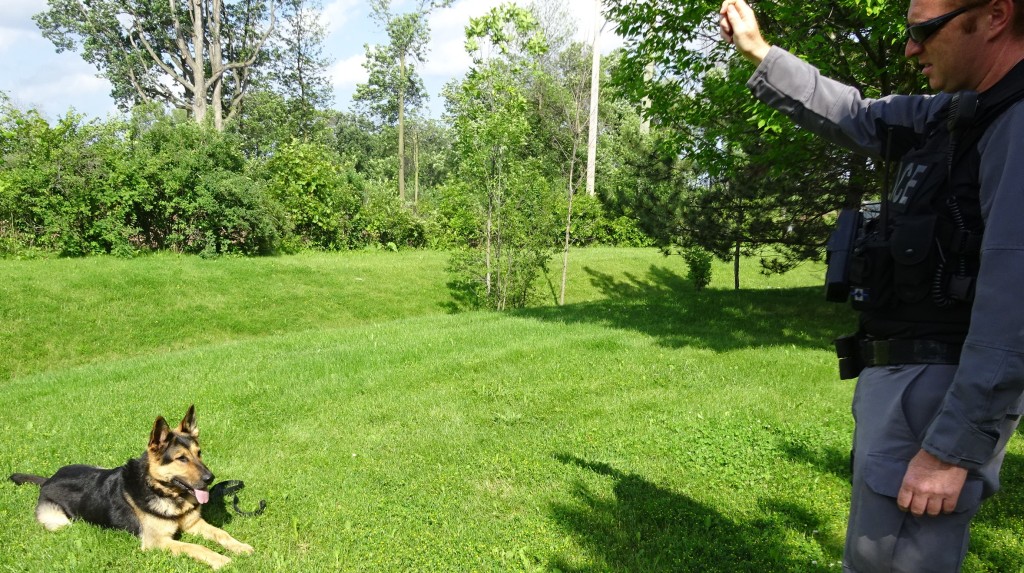 Everything Storm does is the result of a command – given either by hand or by voice from his handler Cst. Matt Lawless What will Cst. Lawless do next – he’s not sure. “I might write the examinations to qualify as a sergeant.”
Storm will live the good life of a retired police dog – Cst. Lawless didn’t say if he would get more than the one meal a day he gets now.

 By Walter Byj By Walter Byj
June 19, 2015
BURLINGTON, ON
For some it is a grand success story while others view it as an experiment that has created a mess. Either way, it has created a logistics nightmare for boards across the province as educators try to run both a successful English program along with a strong French Immersion program.
 Busing students to schools with a French immersion program adds to the problem – and the cost. School busing, disruption of community schools, huge uptake in French Immersion and a shortage on competent French teachers in Ontario is forcing many boards to review their current implementation of French Immersion.
In Halton, the board recently created the Program Viability Committee (PVC) whose goal was to do a thorough review of the challenges that French Immersion has placed on the English program and to then propose a number of solutions that could alleviate any current problems.
The committee, which consists of 22 members, includes the Director of Education, board superintendents, schools principals and three trustees. The trustees are J. Oliver (Oakville, K. Graves (Milton) and R. Papin (Burlington).At the recent board meeting committee chair S. Miller (Associate Director of Education) presented to the board the initial written report.
Miller began his presentation stating that French has had a presence in Ontario for over 400 years. He then when on to explain that although the Halton Board has a very robust French Immersion program, there are some unintended consequences, particularly in some of the dual track schools, where there is a low uptake in the English program.
He stressed that the mandate of this committee was not just French Immersion, but of both French and English programs to ensure that students in both are receiving the best education possible. He did concede that this will not be easy and that no solution will be perfect.
 French immersion – not as easy to deliver as many think – resources not always available. He reiterated that many boards are facing the same issues and reviewing how they face those challenges helps Halton in finding a solution. The report contained a number of appendices that contribute to the current situation. These will be reviewed at a later date.
Following is the initial recommendations that have been presented to the board. A more detailed review of the factors leading to these recommendations along with pros and cons will follow in part two of this report.
RECOMMENDATION 1:
Be it resolved that the Halton District School Board present the following options for the delivery of French Immersion to the public in the Fall of 2015 for the purpose of receiving feedback, considerations and comments. Feedback will be brought to the Board for consideration in the delivery of French Immersion programming:
1. Option 1: Grade 1 (early) French immersion remains a 50% French 50% English delivery model, but entry to FI will be capped. The method of capping would be determined at a later date.
2. Option 2: Grade 1 (early) French Immersion remains at 50% French and 50% English, however all FI programs will be delivered in single track FI schools. French Immersion will be phased out of dual track schools and no new dual track schools will be considered. The location of the single track schools will be determined at a later date.
3. Option 3: French Immersion will commence at a later entry point (mid entry); Grade 4. This will result in the delivery model of FI moving from a 50% model to at least a 80% French Immersion model. In addition the delivery of FI will occur in dual track schools only.
4. Option 4: French Immersion will commence at a later entry point (mid entry); Grade 4. This will result in the delivery model of FI moving from a 50% model to at least a 80% French Immersion model. In addition the delivery of FI will occur in single track FI schools only.
RECOMMENDATION 2:
Be it resolved that the Halton District School Board initiate a community consultation/feedback process with the process and the method of consulting and communicating to the public coming to the Board of Trustees before the end of September 2015 for information.

 By Walter Byj By Walter Byj
June 19, 2105
BURLINGTON, ON
Halton elementary students from senior kindergarten to grade seven will be able to pick up their report card sometime between August 31st and September 3rd. at the school the student attended in 2014/15.
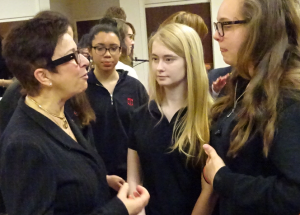 If these students were elementary students and were graduating this year – they will get their report cards before the end of the month. If not – they will get something in the mail before September. For those report cards not picked up, they will be mailed to the families concerned.
Trustees approved an expenditure of $100,000 to cover the cost of inputting the information during the summer of 2015. The report cards will reflect grades/achievement levels and learning skills.
They will not include any comments.
For those graduating from their particular school, report cards will be issued June 24th.

 By Pepper Parr By Pepper Parr
June 18, 2015
BURLINGTON, ON
Rob Peachey was one of six people who travelled to Holland for the 70th Anniversary of the ending of the Second World War last month. Canadian troops liberated much of Holland including Apeldoorn, a city Burlington was twinned with n 2005.
 Rob Peachey, part of the Burlington delegation that went to Holland. Peachey handles parks and open spaces development for the city which includes the park the city created on Elgin Street. Apeldoorn did the same thing in Holland where visitors can see the Burlington Park.
What does a Canadians parks and open spaces bureaucrat say to a bureaucrat in another country where land use is significantly different than ours and administrative practices are also considerably different?
The thing that struck Peachey, almost literally, was the number of bicycles on the streets – “the things were everywhere”, he said. “We just don’t see that kind of cycle traffic in Burlington” Peachy added.
Peachy found that civil servants in Apeldoorn have yet to create the kind of administrative tools we have in Burlington.. Peachey spent some of his time explaining our Results Based Accountability and Service Based Budgeting to his peer in Holland and expects to trade information with them as he continues to maintain the relationship he now has.
They are quite a bit ahead of us with their community gardens said Peachey.
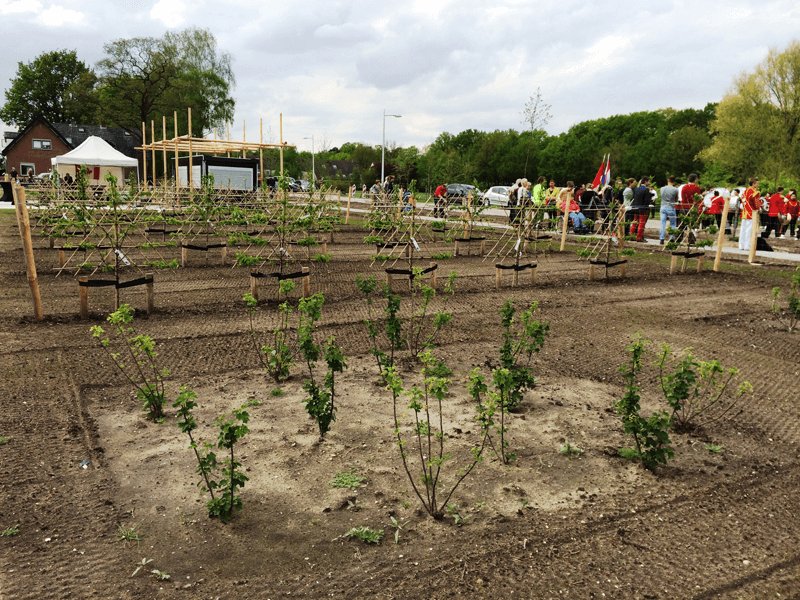 Community gardens in Apeldoorn Peachey added that the sports fields are not in the inner parts of the city but more on the outskirts and that there are fewer parks and none of them have the “jungle gyms” for children to play on that North Americans have.
Peachey did get to ride a bicycle – the hotel rents them” he explained. Bikes are a serious mode of travel in Apeldoorn – there are people in suits peddling to work in the morning.
He noted that there were no picnic tables in the parks that he saw and nothing in the way of public art and added there wasn’t much grass around properties in the city.
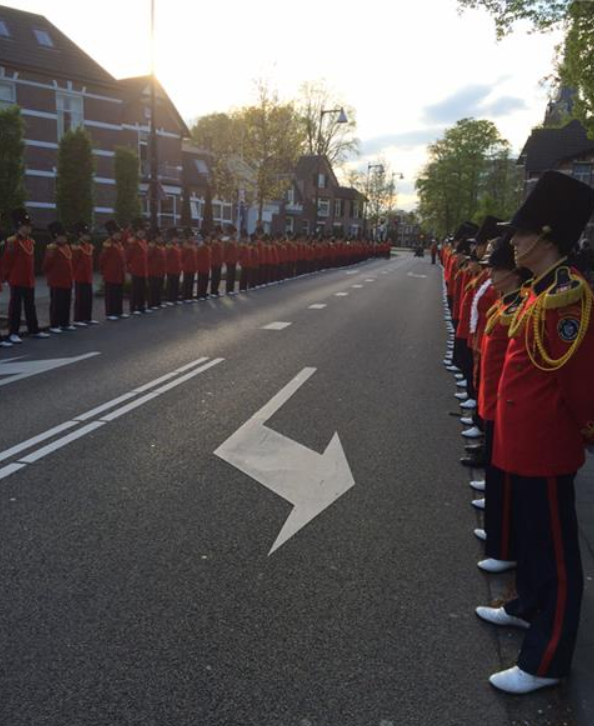 Members of the Burlington Teen Tour Band lined the streets of Apeldoorn during the celebration of the dead event which was part of the 70th Anniversary of the end of World War Two. The “celebration of the dead” event in which the Burlington Teen Tour Band played a significant role was, said Peachey, one of the most moving public events he has ever witnessed. “There was dead silence for the minute that the city went mute”. I found myself tearing up he added.

 By Walter Byj By Walter Byj
June 18, 2015
BURLINGTON, ON
“There was no long term plan or goal to achieve when entering the workforce. I just wanted a teaching job” said Director of Education David Euale.
 David Euale, retiring Director of Education for the Halton District School Board However, as his qualifications grew and opportunities arose, he was always anxious to take the next step. And thus began his progressive career from teacher to vice-principal to principal, superintendent, and one year at the ministry to his current position as Director of Education of the Halton District School Board for the past five years. Euale retires in August
He did not bring a grand plan with him when he arrived in Halton; rather his mandate was to ensure that the board fulfilled its objectives. One key element was to set a multiyear plan, which was accomplished in three months, and became his mandate for the following five years.
 Euale leaves a board of education that ranks amongst the top in Ontario in terms of how well the students do on test scores. He also leaves before a possible strike in September. Students at Hayden High develop their cooking skills.
Student achievement is always any director’s challenge he said and in Halton this was even harder as the scores were already near the top of the province. He feels that this challenge was met as he and the board have raised the bar during his tenure.
One source of pride was his work in e-learning in Halton. He was somewhat surprised that only ten courses were being offered electronically when he arrived. Four years later, 38 courses are now available with over 1,000 teachers having received E-learning training. E-learning could easily be used as a supplement to existing courses.
He has served with three separate boards and he is extremely proud of the quality of the trustees and they compare very favourably with other boards in the province. He feels that the trustees are not only dedicated, but also show an insight to the needs of students. The public in Halton is more aware and involved in their community and this contributes to the quality of the trustee he said.
This reporter sits in a different part of the room than the Director of Education – as I watched the approval of the budget there wasn’t a single question from any of the Burlington trustees on a budget that was to spend $685 million on operations and $62.6 million on capital projects. I thought there would be at least one question from one of the trustees.
With one of the few boards showing student growth, three secondary and nine elementary schools in the past five years this continued growth has been challenging.
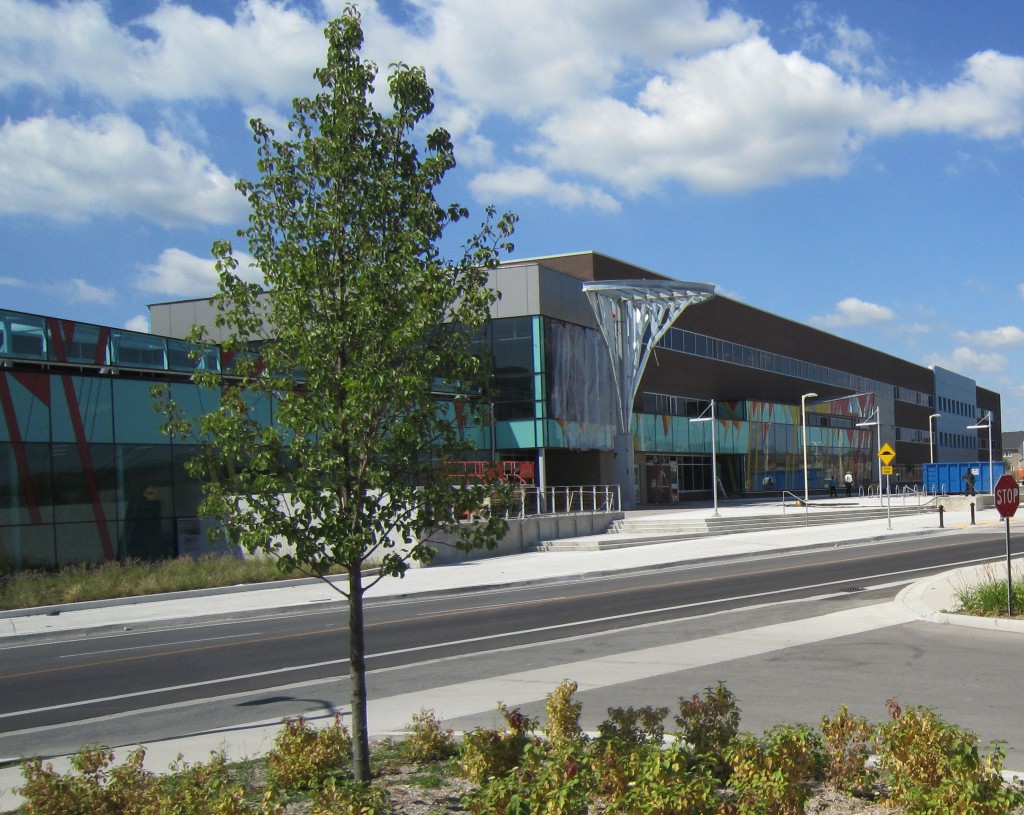 One of the early fully integrated community complexes that includes a Recreation centre, a public library and a high school were built in Alton while Euale was Director of Education. He is a supporter of the new health and physical education curriculum as new technology has opened up a broad base for enquiring minds. We as educators need to respond to the free flowing information that is available through the educational process he said rather than leaving the internet as an educator. Our board has received its fair share of calls and I believe that our staff and trustees have handled them in a professional manner.
He feels that the students of today are better educated today than 15 years ago. We are graduating more students from secondary schools and with the new technologies; they are better researchers, better problem solvers and better collaborators.
Euale did concede that he does not know if the current students know their history facts or times tables as those in previous years, but with the teaching of the new technologies, something may drop by the wayside. Overall, we are seeing a much better educated student.
When the subject of the website was approached, he quickly conceded that there was work was needed. There is a lot if information on the site but finding it can be arduous at times. A total of $100, 000 in the most recent budget has been set aside to improve the site.
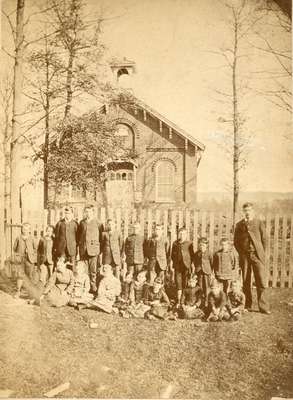 Euale knows that today’s students are getting much better educations – and that those students are going into a world that is a lot different than the one he grew up in. When he leaves the board in August, Euale feels the challenges for the new director will be to maintain the high performance in Halton, to continue to focus on student achievement and manage expectations of parents with the funds that are available. Over the past five years he has managed to build and guide a very competent staff that if managed correctly should continue the high standard within Halton.
With this being his third retirement, first from the Upper Grand School Board, then from the ministry and now from Halton, don’t place any bet that he won’t show up again somewhere in the educational field.

 By Pepper Parr By Pepper Parr
June 18, 2015
BURLINGTON, ON
The Sculpture Garden in the Courtyard of the Art Gallery of Burlington is going to get a treatment with the work of Spanish artist Jordi Alfaro, originally from Spain but now a resident of Dundas, Ontario.
 Spanish artist Jordi Alfaro with one of his Arrieros exhibition pieces. Photo Credit Reid Flock Designed specifically for the unique architectural space, Alfaro has transformed the AGB courtyard into a sculpture garden for his Arrieros exhibition.
Alfaro has used the abstract nature of the design of the Courtyard and created a series of monolithic forms that complement the straight horizontal and vertical lines of both the architecture and the plantings of the space.
 Polished pieces appear to be hiding in the lush vegetation of the Courtyard at the AGB. His single large sculptures and his stacked round forms have the evocative sense of prehistoric monuments like Stonehenge in England, or Carnac in France, but their often bright coloured glazes and crisp bands of colour hint at minimal sculpture out of the 1960’s.
Placed in amongst the plantings or out on the concrete surfaces, these works engage the viewer asking them to navigate the space with an increased awareness.
 There is some of the contemplative nature that one finds in some Zen stone gardens in this piece – part of the Arrieros exhibition. These works suggest the contemplative nature that one finds in the Zen stone gardens in Japan but is totally unique to this artist. The quiet strength of these works transforms the space into as oasis of calm on an otherwise busy day.
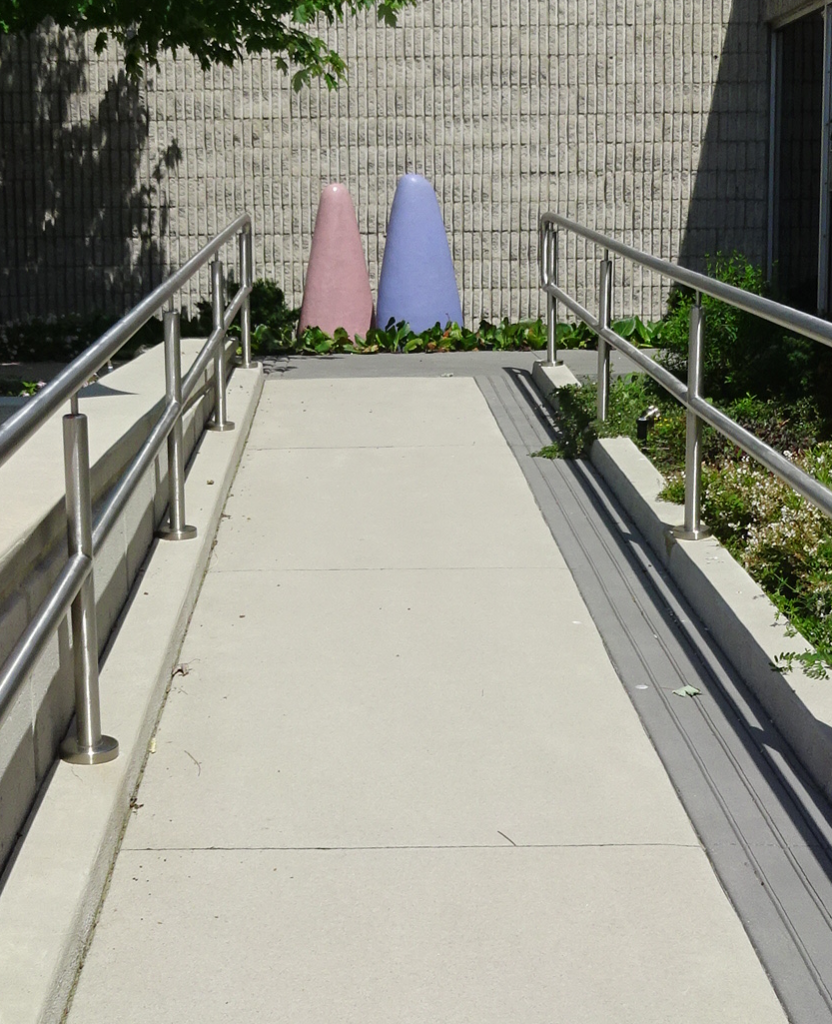 Looking like sentries at the top of an entrance these two piece in the Arrieros exhibit wait for a visitor There is a quietness about the Courtyard – the kind of place to take in some of the sunshine, read a newspaper over a cup of espresso.
Curated by Jonathan Smith, the AGB-tailored exhibition will run from June 13, 2015 to September 30, 2015, with the opening reception taking place Sunday, June 28, 2pm – 4pm.
AGB Members will be offered free admission to the exhibition. More information on the benefits of AGB membership can be found here

 By Staff By Staff
June 17, 2015
BURLINGTON, ON
It’s all about the environment – global warming, flooding and much different weather patterns than we are used to – there is a lot of talk; the fifth State of the Environment Report (SOER) for Burlington, prepared by the Sustainable Development Committee was presented to a Council Standing Committee earlier this week. SOERs have been presented to council in 1998, 2004, 2007 and 2011.
 Does sustainability mean ensuring the Escarpment is never touched? The purpose of the document is to provide information on the state and health of Burlington’s environment and to make recommendations for improving it.
The SOER identifies eleven themes, and reported on:
Why it was measured
What was measured – indicators
What was found – indicator values and trends
What is happening to address the issue
The 2015 document points to progress is being made in certain areas of the city related to environmental sustainability:
The Cootes to Escarpment Land Strategy and Park System has partnered various levels of government, agencies, utilities, and non-government organizations to preserve and expand natural areas and engage the community on the value of these lands. The system is one of the most biologically rich areas in Canada with more than 1,580 documented species and habitat for more than 50 species at risk.
Under Places to Grow and with a firm urban and rural boundary, the city will continue to transform from a suburban community to a more urban built environment that should support a sustainable transportation network.
Support for urban agriculture and local food opportunities, such as community gardens, continues to grow.
Halton Region continues to experience success in reducing the waste diversion rate by expanding programs for local residents.
Greenhouse gas emissions from the community and city operations are decreasing.
Water efficiency efforts appear to be working as water consumption on a per capita basis appears to be decreasing (for low rise residential development). However, it is acknowledged that there are challenges facing the city and partner agencies going forward:
The uncertainty of the impacts of climate change, not just with local infrastructure, but with health, food security, the natural environment, among others. A regional adapation strategy should be considered.
The automobile is still the preferred mobility option in Burlington and changing the modal split in favour of other sustainable modes like transit, walking and cycling will require ongoing support in these areas.
The urban forest is under threat by invasive species and urban development, making the Urban Forest Master Plan an important resource.
The Sustainable Development Committee recently prioritized their top ten recommendations in the SOER:
 The use to which we put the land we have – who gets to make those decisions? LAND USE PLANNING:
1. That the city focuses on future land planning opportunities for mobility hubs, with design principles supporting energy efficient and smart development with a sustainable transportation network.
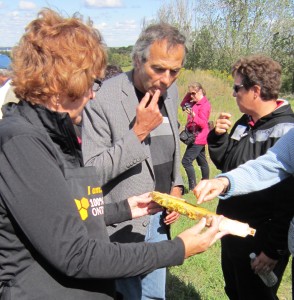 Regional Chair Gary Carr tasting honey while on an agricultural tour. RURAL LANDS & AGRICULTURE
2. That the city expand the position and responsibilities of the Community Garden Coordinator from seasonal part time to support the local food movement in Burlington, by encouraging local food production and distribution, and supporting urban and rural agricultural programs.
TRANSPORTATION:
3. That the city undertake Transportation Modal Split surveys on a more consistent basis than the Transportation Tomorrow Survey. It is recommended that this survey include questions to detail why residents of Burlington choose their preferred mode of transportation and what steps need to be taken to encourage residents to rely on more sustainable transportation options.
ENERGY:
4. That the city continue the implementation of the Community Energy Plan with a focus on fuel and cost savings, by switching from gasoline vehicles to electric/hybrid vehicles, investigating opportunities for local sustainable generation (e.g. district and renewable energy), improving efficiency, increasing community engagement and improving the built form.
 Water – it can work for us and it can work against us. Either way it is a resource to be managed so that it can sustain the community. WATER:
5. That the city implement repairs and actions to mitigate future flooding impacts based on the results of the current study being carried out by the City of Burlington, Region of Halton and Conservation Halton in a cost effective manner. The study should include an update of the design standards for the stormwater system considering climate change impacts. That the city follow the principles (e.g. electrical boxes above flood level) required by Alberta when remediation is being carried out on residences, etc. (particularly where residences have been flooded repeatedly).
6. That the city request a geotechnical report through the development review process to ensure the proper design is applied when building construction takes place near or below the water table, particularly in low lying areas where the water table level is near the surface. Ensure the Ontario Building Code requirements are implemented, such as waterproofing of the foundation walls and measures to mitigate a reduction in the bearing capacity of the soil.
7. That the city, in partnership with Conservation Halton as appropriate, undertake a series of pilot projects on city properties using Low Impact Development stormwater management techniques to treat stormwater runoff at its source rather than conveying it through the traditional stormwater infrastructure.
CLIMATE CHANGE:
8. That the city ensure community resiliency by working with regional partners including Halton Region, Conservation Halton and the local municipalities to develop a climate change adaptation strategy.
SUSTAINABLE BUILDINGS & DEVELOPMENT:
9. That the city implement green building standards to require builders to include sustainable building measures in their projects.
10. That the city continue to undertake a training program for city staff who deal with planning applications and building permits to obtain LEED accreditation and to make use of the LEED Neighbourhood checklist developed by the SDC.
The Sustainability Advisory Committee is made up of volunteers who have taken on a mammoth task. At times the city has asked them for comments they weren’t able to provide; with these periodic reports the city gets solid data but then struggles to leverage the data and inform the public.
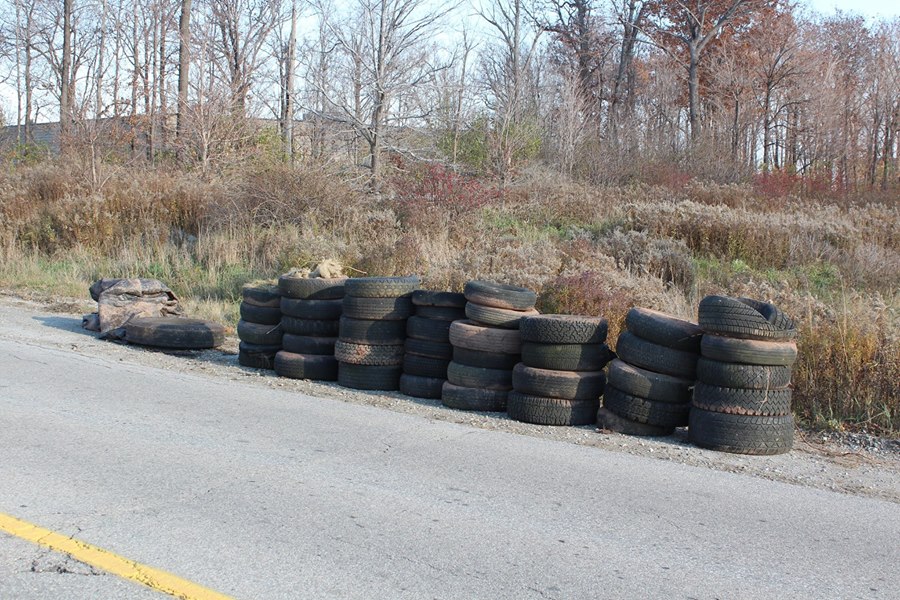 Tires pulled out of creeks by clean up crews – the tires got dumped there by people who should know better. Burlingtonians are particularly willing to pitch in and do what needs to be done to make the difference. Thousands turn out for the Green Up – Clean up event; hundreds trooped to the Beachway to plant trees. The task now is to get the message out – which is easier said than done. The Sustainable Development Committee plans to make their report available within the community. Copies will be distributed to the Burlington Public Libraries and local senior elementary and secondary schools as a resource document. An electronic version will be provided on the city’s website. The Committee will promote the on-line link to the SOER to minimize the number of printed copies.
It is going to take more than dropping copies off at the library and at schools to get the depth and breadth of just what sustainability is all about. On that score the committee gets a low C grade – great stuff but it has to go much further than a presentation to council and being put in the libraries.
It comes back to that leadership issue – doesn’t it?

|
|
 By Staff
By Staff These performances will take place on a particular night to introduce these artists to our patrons and a wider audience.
These performances will take place on a particular night to introduce these artists to our patrons and a wider audience.



























































 It was evident there was passion, commitment and dedication from the members. The members were so pleased to be able to support local charities in the Burlington Community. 100 Women Who Care Burlington meets four times a year and each member donates $100 to the winning recipient nominated by a member.
It was evident there was passion, commitment and dedication from the members. The members were so pleased to be able to support local charities in the Burlington Community. 100 Women Who Care Burlington meets four times a year and each member donates $100 to the winning recipient nominated by a member.
























